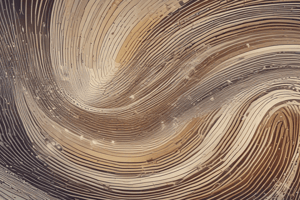Podcast
Questions and Answers
What are vibrations?
What are vibrations?
Oscillations or back-and-forth motions occurring in a physical system.
How are sound and vibrations related?
How are sound and vibrations related?
Sound is produced when an object vibrates, causing pressure changes in the surrounding air.
Describe the role of vibrating objects in sound production.
Describe the role of vibrating objects in sound production.
Vibrating objects set air molecules in motion, producing pressure variations that create sound.
What is the primary medium through which sound travels?
What is the primary medium through which sound travels?
How do musical instruments produce sound?
How do musical instruments produce sound?
How does a guitar string produce sound when plucked?
How does a guitar string produce sound when plucked?
What role do the vocal cords play in sound production of the human voice?
What role do the vocal cords play in sound production of the human voice?
What happens when sound waves reach our ears?
What happens when sound waves reach our ears?
Why is knowledge of vibrations essential in various fields?
Why is knowledge of vibrations essential in various fields?
How can understanding the physics of sound production help in daily life?
How can understanding the physics of sound production help in daily life?
Flashcards are hidden until you start studying
Study Notes
Sound Production: Exploring Vibrations
Sound, a fundamental part of our daily lives, is created through the vibration of matter. Understanding vibrations and their role in sound production is key to appreciating the world around us.
Vibrations: The Basics
Vibrations are oscillations, or back-and-forth motions, occurring in a physical system. When an object vibrates, it moves back and forth around an equilibrium position. These vibrations can be caused by external forces or internal factors, such as elastic potential energy in a stretched spring.
Vibrations and Sound Production
Sound is produced when an object vibrates, causing pressure changes in the surrounding air. These pressure fluctuations travel as waves that reach our ears, creating the sensation of sound. Sound is a form of mechanical wave and is specific to the medium through which it travels, such as air, water, or solids.
Sound Sources: Vibrating Objects
Sound sources can be described as objects that vibrate and set air molecules in motion, producing pressure variations. These sources include musical instruments, such as guitars, violins, and pianos, as well as human voices and everyday objects, like clapping hands or knocking on a door.
Sound Production: Instruments and Their Vibrations
Musical instruments produce sound through the vibration of various materials, such as strings, membranes (like in drums), or columns of air (like in clarinets or flutes). For example, when a guitar string is plucked, it vibrates, causing the air nearby to move in and out rapidly. This movement of air creates the pressure variations that we perceive as sound.
Sound Production: The Human Voice
The human voice generates sound through the vibration of the vocal cords. When air from the lungs moves past the vocal cords, they vibrate, creating sound waves that travel through the mouth and nose. The shape of these cavities, together with the position and shape of the tongue, lips, and jaw, affect the sound we produce.
Sound Production: The Hearing Process
When sound waves reach our ears, they cause the eardrum (tympanic membrane) to vibrate. These vibrations are then transferred via three small bones in the middle ear (malleus, incus, and stapes) to the cochlea, a fluid-filled, spiral structure in the inner ear. The mechanical vibrations in the cochlea are converted into electrical signals that travel to the brain via the auditory nerve, allowing us to hear.
Sound Production: Applications and Considerations
Knowledge of vibrations and their role in sound production is essential in various fields. Music composers and performers need to understand how different vibrating systems interact to create pleasant sounds. Engineers design systems like speakers and microphones to optimize sound production and transmission. Understanding the physics behind sound production also aids in the prevention and treatment of hearing loss.
In summary, sound production is the result of vibrations in matter, which create pressure variations in the surrounding medium. By understanding the mechanisms behind these vibrations, we can appreciate and create sound more effectively in our daily lives.
Studying That Suits You
Use AI to generate personalized quizzes and flashcards to suit your learning preferences.




